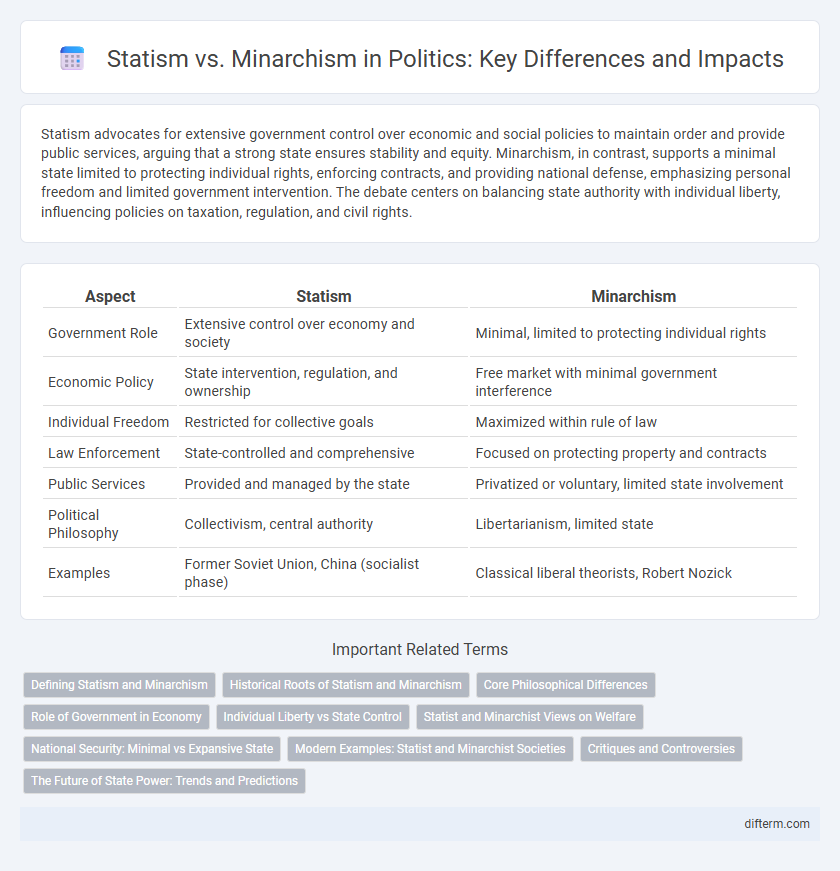Statism advocates for extensive government control over economic and social policies to maintain order and provide public services, arguing that a strong state ensures stability and equity. Minarchism, in contrast, supports a minimal state limited to protecting individual rights, enforcing contracts, and providing national defense, emphasizing personal freedom and limited government intervention. The debate centers on balancing state authority with individual liberty, influencing policies on taxation, regulation, and civil rights.
Table of Comparison
| Aspect | Statism | Minarchism |
|---|---|---|
| Government Role | Extensive control over economy and society | Minimal, limited to protecting individual rights |
| Economic Policy | State intervention, regulation, and ownership | Free market with minimal government interference |
| Individual Freedom | Restricted for collective goals | Maximized within rule of law |
| Law Enforcement | State-controlled and comprehensive | Focused on protecting property and contracts |
| Public Services | Provided and managed by the state | Privatized or voluntary, limited state involvement |
| Political Philosophy | Collectivism, central authority | Libertarianism, limited state |
| Examples | Former Soviet Union, China (socialist phase) | Classical liberal theorists, Robert Nozick |
Defining Statism and Minarchism
Statism advocates for significant government intervention and centralized control over economic and social policies to promote collective goals and stability. Minarchism, by contrast, supports a minimal state whose primary role is limited to protecting individual rights through institutions like the police, judiciary, and national defense. The ideological divide centers on the extent of government power versus individual liberty in managing societal affairs.
Historical Roots of Statism and Minarchism
Statism traces its historical roots to early centralized civilizations, exemplified by ancient Mesopotamia and Imperial China, where strong government control was essential for maintaining order and infrastructure. Minarchism, emerging from Enlightenment thinkers like John Locke and Adam Smith, advocates for minimal government focused primarily on protecting individual rights and property. The tension between these ideologies reflects a long-standing debate about the optimal scope of government authority in society.
Core Philosophical Differences
Statism advocates for extensive government intervention in economic and social life, viewing the state as essential for regulating markets and ensuring social welfare. Minarchism supports a minimal state limited to protecting individual rights through law enforcement, defense, and judiciary functions, emphasizing personal liberty and voluntary exchange. The core philosophical difference lies in the scope of state authority and the balance between collective control versus individual autonomy.
Role of Government in Economy
Statism advocates for extensive government intervention in the economy, including regulations, public ownership, and wealth redistribution to achieve social equity and economic stability. Minarchism promotes a limited government role confined to protecting individual rights, enforcing contracts, and maintaining national defense, emphasizing free-market mechanisms for economic growth. The debate hinges on balancing state control versus personal economic freedom to optimize prosperity and societal welfare.
Individual Liberty vs State Control
Statism emphasizes centralized state control to regulate society and economy, often prioritizing collective goals over individual freedoms. Minarchism advocates for a minimal state limited to protecting individual rights, asserting that extensive government intervention undermines personal liberty. The core conflict revolves around balancing government authority with safeguarding individual autonomy in governance.
Statist and Minarchist Views on Welfare
Statists advocate for comprehensive welfare programs funded by the government to reduce inequality and provide social safety nets, believing that state intervention is essential for protecting citizens' well-being. Minarchists argue for minimal state involvement, emphasizing individual responsibility and private charity as more efficient and morally preferable means of addressing social welfare. The debate centers on balancing government authority with personal freedom, highlighting differing views on economic equity and the role of the state in citizens' lives.
National Security: Minimal vs Expansive State
Statism advocates for an expansive state role in national security, emphasizing centralized control, extensive intelligence agencies, and a large standing military to address threats comprehensively. Minarchism supports a minimal state approach, limiting national security functions to essential defense forces and basic intelligence operations, prioritizing individual liberty and economic freedom. The debate centers on balancing effective protection with preserving civil liberties and avoiding governmental overreach.
Modern Examples: Statist and Minarchist Societies
Contemporary statist societies, such as China and North Korea, exemplify centralized government control over economic and social policies, prioritizing state authority and planned economies. In contrast, modern minarchist examples can be seen in countries like Switzerland and New Zealand, where limited government intervention focuses primarily on protecting individual rights, enforcing contracts, and ensuring national defense. These differing approaches highlight the ongoing global debate over the balance between government power and personal freedom.
Critiques and Controversies
Statism faces critiques for its potential to concentrate excessive power in government, risking authoritarianism and undermining individual freedoms. Minarchism is often challenged for its practicality, with opponents arguing that minimal state functions may be insufficient to maintain order or provide essential services. Debates intensify around government intervention efficiency, balancing state authority with personal liberty, and the viability of voluntary compliance in minimal governance.
The Future of State Power: Trends and Predictions
State power is increasingly challenged by technological advances and rising demands for individual autonomy, prompting debates between proponents of statism and advocates of minarchism. Data from recent political trends indicates a growing preference for decentralized governance models, driven by concerns over government overreach and inefficiency. Forecasts predict that future state structures will likely balance regulatory authority with enhanced civil liberties, influenced by global movements toward digital sovereignty and participatory democracy.
statism vs minarchism Infographic

 difterm.com
difterm.com